The La Marzocco Linea Micra Espresso Machine Is the First Of Its Kind—But It Also Costs Thousands
Dotdash Meredith and Yahoo Inc. may earn commission or revenue on some items through the links below.
This small(ish) but mighty machine delivers commercial-quality results.
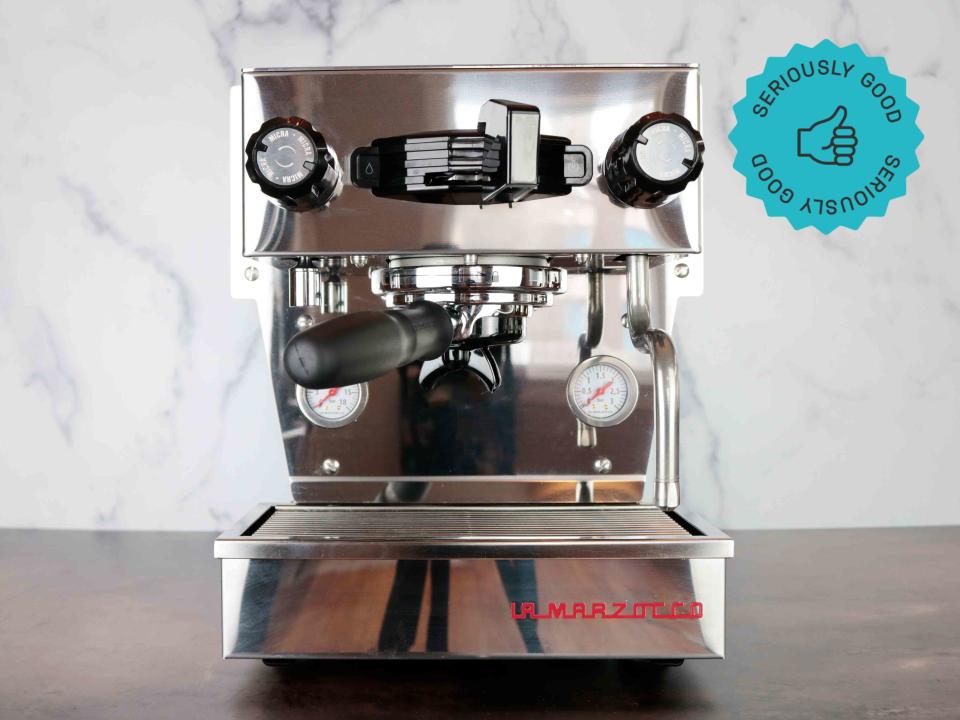
Serious Eats / Jesse Raub
After testing it for two months, we found the La Marzocco Linea Micra pulled pristine shots and steamed glossy milk just as well as its bigger (and even pricier) sibling, the La Marzoccoa Linea Mini. At nearly $4,000, though, it's for a very specific consumer.
La Marzocco is known for making cutting-edge commercial espresso machines that pull precise espresso shots back-to-back in high-volume cafes. In my previous life doing training and events for a coffee roasting company, I dragged the Linea Mini, their first home-friendly machine, all over Chicago for pop-up events. It always impressed me with the power it packed in such a small body. At 70 pounds, however, it still felt more like a small commercial model than something that could fit in my kitchen. So when La Marzocco announced the Linea Micra, an even more countertop-friendly espresso machine, I was intrigued. It boasts the same dual-boiler design and app-connected controls of the Mini, but it's 30% smaller. To find out if it could deliver the same precision and consistency, I used the Linea Micra daily for two months, testing its ability to pull shots and steam milk, and examined how simple it was to use and maintain for those really wanting to invest in an espresso machine. I also looked into why it is so much more expensive than other models we’ve tested.
The Tests
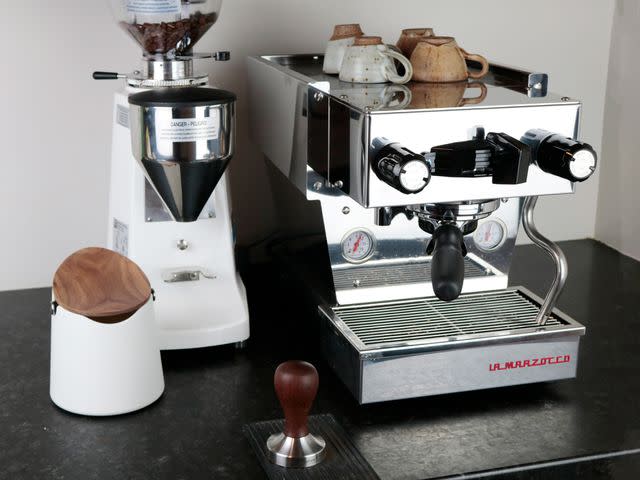
Serious Eats / Jesse raub
Espresso Test: Over a two-month period, I pulled shots of espresso on the Linea Micra using a variety of coffees from different roasters, and a variety of home espresso grinders. I noted if the results were consistent, as well as the flavor of the shots pulled.
Milk Steaming Tests: I steamed milk for lattes, cappuccinos, and cortados, noting the quality of the milk texture, how well it poured into espresso, and the flavor quality of each drink.
Ease of Use and Cleanup Tests: After pulling more than 200 espresso shots with the machine, I noted how easy it was to operate, how well the connected app worked, any noteworthy usability features, and how easy it was to run a cleaning cycle.
What We Learned
It Pulled Delicious Espresso and Steamed Perfect Milk

Serious Eats / Jesse Raub
Even if our latte art skills were slightly rusty, the Linea Micra made a true cafe-quality cappuccino.This machine pulled better-tasting shots than many full-sized commercial machines I’ve worked with, and it also steamed perfect, glossy milk. While most home espresso machines require some finagling to get the best results, the Micra delivered amazing espresso and steamed milk every single time. Even though it was just a fraction of the size of a commercial machine, I truly felt like I was back working on a professional, 200-pound espresso machine again.
It Was a Sleek, Sturdy Piece of Equipment
You can tell the Linea Micra is well-made. The stainless steel design is functional (and in stark contrast with the plastic panels on most home machines) but also has a sleek, modern look. And while the outside is quite sturdy, inside it's as intricate as clockwork, a well-oiled machine capable of pulling perfect shots every time. It's built with the exact same care and quality (and high-end materials—steel this thick ain't cheap!) as any of La Marzocco's full-sized machines.
Dual Boilers Allowed You to Steam Milk and Pull Shots Simultaneously
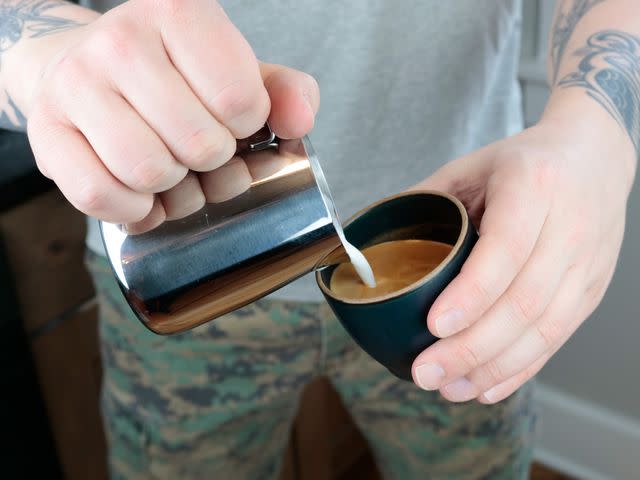
Serious Eats / Jesse Raub
It's easier to preserve milk texture and espresso quality for pouring cappucinos when you can steam milk and pull shots at the same time.The Linea Micra is a dual-boiler machine, meaning it has a dedicated brew boiler and a dedicated steam boiler. This allows you to pull shots and steam milk simultaneously without one affecting the other. It’s a design that’s usually only seen in large, commercial machines or other extremely high-end home models. Conversely, single-boiler machines require switching to steam mode and waiting up to five minutes before it gets up to temperature, and by that time, the espresso shot is already oxidizing and losing flavor. Even pulling back-to-back shots on a single-boiler machine can trigger a minutes-long refractory period while the water heats back up, making it difficult to serve a friend a latte if you want one yourself, too.
Another distinguishing feature of the Micra is that the brew boiler is fed with water that’s preheated by the steam boiler first. “Preheated water allows for back-to-back coffee brewing without loss of temperature stability and allows us to use a smaller coffee boiler, which is faster to heat up and more responsive to temperature change,” says La Marzocco senior product manager Scott Guglielmino. With a PID controller (a device that predicts temperature swings that’s also used in immersion circulators and convection ovens), the Micra features the same selling points that a $23,000 commercial machine has, only smaller. Making a cappuccino on the Micra feels like I’m back behind the counter working on a full-sized machine, timing an espresso shot with my left hand while steaming milk with my right.
A Rotary Pump Offered Smooth (and Quiet) Operation
The machine also features a rotary pump, which is extremely rare in home espresso machines. Rotary pumps use a motor that draws in air to spin a segmented disc, which pressurizes the water through the espresso machine. These pumps are what commercial machines use due to their long lifespan, quiet operation, consistent pressure, and reliability. Most home machines use a vibratory pump, which pushes an electromagnetic piston back and forth to create pressure. They’re loud, less reliable, and vibrate the entire machine while running, but they’re also much smaller and cheaper.
Both styles of pump deliver the pressure needed for making espresso, but a rotary pump will last much, much longer, and just feels better to use. It’s like shutting the door of a nice car with a satisfying thud—it might not have a huge impact on the car’s ability to drive, but it’s a much better user experience than a door that creaks as it closes.
The Micra Delivered Pristine Espresso Flow

Serious Eats / Jesse Raub
Shots from the Linea Micra flowed smoothly every time.A major difference between the Linea Micra and other home espresso machines I’ve tested is the flow of the espresso itself. Great-tasting espresso requires a precision grind setting, and the only way to evaluate how coarse or fine your coffee is ground is by pulling a shot and timing how long it takes for the water to flow through. The Micra’s rotary pump ensures consistent and smooth pressure delivery, meaning you can adjust your grind and watch the espresso flow speed up or slow down in relation to the grind size, and once I was dialed in for a specific coffee I didn’t have to make extra adjustments. Machines with a vibratory pump varied more from shot to shot, even with the same grind setting and the same amount of coffee. Not having to constantly change the grind meant more time enjoying the espresso shots I was pulling and less time tinkering with grind settings.
It Had an Easy-to-Use, Unfussy Interface
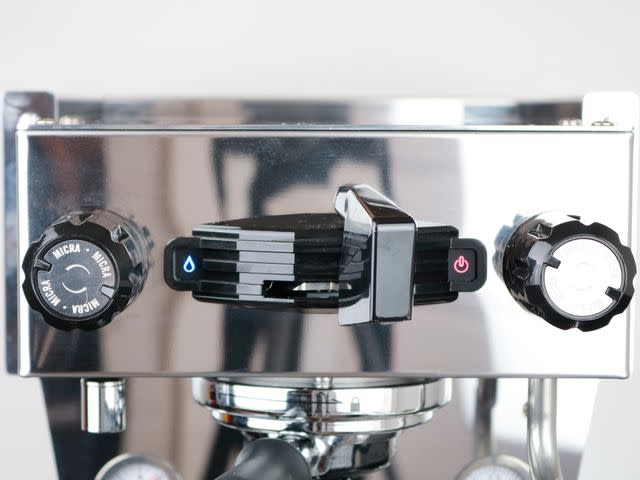
Serious Eats / Jesse Raub
With its high price tag, people might assume that this machine comes with extra programmable features or multiple buttons. Instead, the Micra focuses on perfectly executing the two things it’s designed to do: pull shots and steam milk. There’s an on switch, dials for hot water and the steam wand, and a paddle to start and stop your shots—and that’s it. Both the dials and the paddle are responsive and easy to maneuver, letting the user focus on good espresso technique without getting distracted.
Small Design Details Added to the Overall User Experience
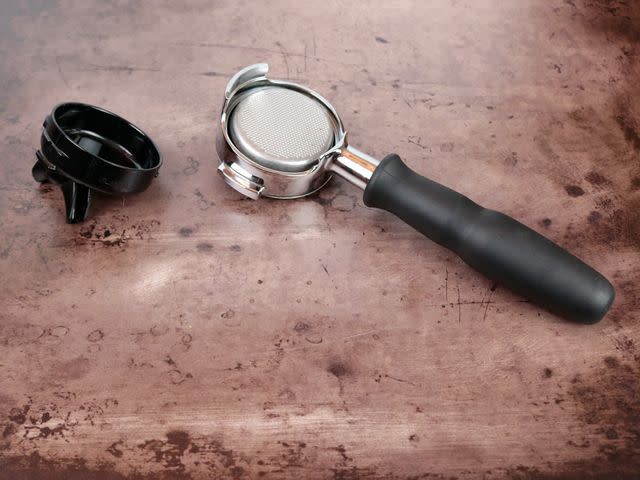
Serious Eats / Jesse Raub
The twist-on spouts made it easy to swap to a bottomless portafilter, and it was just one of the design details we welcomed.Though it features a stripped-down user interface, there were some details that greatly improved the user experience: the drip tray bobber, convertible portafilter, and deck lights. Nothing ruins your afternoon espresso like an overflowing drip tray, and the Micra features a red bobber that pops up and blocks you from putting a cup under the portafilter when the drip tray is full. The portafilter itself is also unique: the plastic spouts screw on and off with a quick twist, converting it into a bottomless portafilter if you want to watch the streams of espresso drop directly from the basket. This also means there’s less metal that needs to preheat before you pull a shot—full-metal portafilters require 20 to 30 minutes to preheat, while the Micra portafilter was ready after 15. But what’s really fun are the deck lights: when you engage the grouphead to pull a shot, directional lights switch on to illuminate the front of the machine, allowing you to see your espresso flow even if the machine is in the shadows.
Then there’s the app, which allows you to adjust coffee boiler temperature, steam boiler pressure, schedule auto on/off times, and even saves your stats so you can see how many shots you’ve pulled. Though I found it was slow to connect the machine to my phone, the app’s simple interface made it easy to adjust settings, even if it was a little bit superfluous.
Its Small Size Made Using Taller Cups Awkward
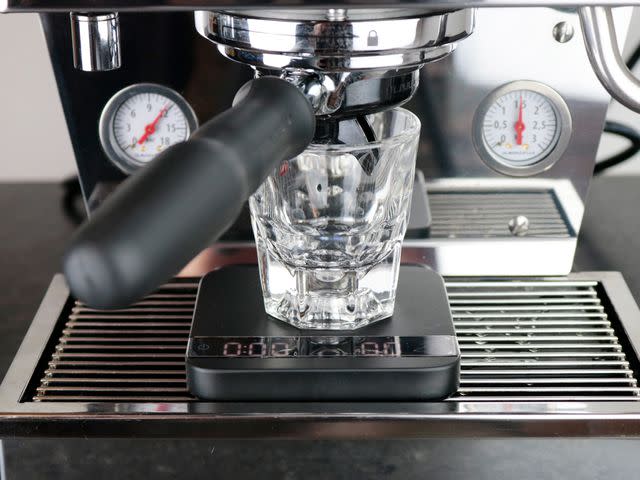
Serious Eats / Jesse Raub
Some taller cups needed to be tilted to fit under the spouts.The biggest downside of the Micra was also its biggest upside: its size. Because of its smaller footprint, the deck clearance between the portafilter spouts and the drip tray is only three inches. Wider, cafe-style ceramics could be maneuvered under the spouts with a scooping motion, but if you wanted to make an 8-ounce or bigger Americano, you’d have to pull the shots into shot glasses first. It’s a small gripe, but more noticeable since everything else on the machine works so seamlessly.
The Steam Wand is Powerful, If Slightly Awkward to Use
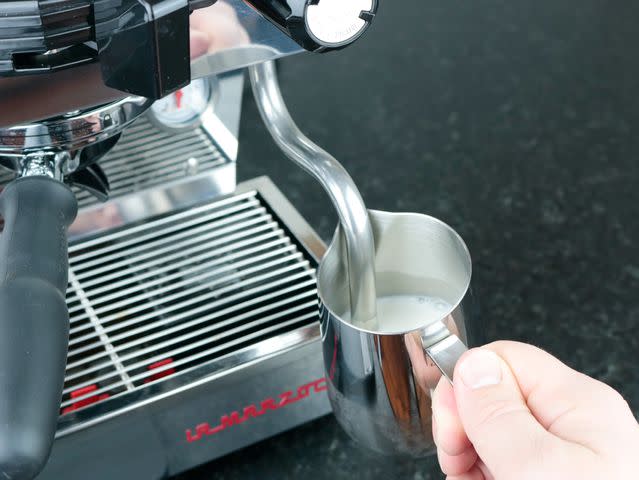
Serious Eats / Jesse Raub
The shorter steam wand took some getting used to, but steamed professional quality milk texture.Because of the lower deck clearance, the Linea Micra steam wand, which is only three inches long, is shorter than I’d prefer. The overall length was cut down so that it could still purge steam directly into the drip tray, but this also means it’s difficult to keep the tip submerged when steaming milk. When making smaller drinks, the tip of the steam wand often grazed the surface of the milk, adding more air and creating more foam than I’d intended. Eventually, I was able to re-orient the wand for an easier-to-use angle, but it still required steaming a few extra ounces of milk to develop the right texture. All that said, the steam power was remarkable, and unparalleled in an espresso machine of this size.
The Automatic Cleaning Cycle Simplified the Process
La Marzocco has plenty of cleaning guides on its website, but the machine also has an automated backflush cycle that can be triggered with the app. The main way to clean an espresso machine is to run coffee detergent back up into the machine with a solid basket insert, and the automated cycle on the Micra walks you through it. It was great to have a streamlined process that cycles the machine for you, which let me work on cleaning the screen and the portafilter basket by hand.
The Verdict
La Marzoccousa Linea Micra

High-end espresso equipment won’t magically make your coffee taste better, but it will remove barriers to achieving the best quality possible. The Linea Micra is very expensive (it’s $3,900), but it’s also unparalleled in how well it pulls shots and steams milk. It’s built to commercial-quality standards, which means it’s designed to last and can be easily repaired. The Linea Micra is truly an exquisite espresso machine, but at a price that’s likely too high for anyone but hardcore home enthusiasts. Those who are new to home espresso can still pull great shots with our top espresso machine picks, which are all a fraction of the cost.
The Pros
The Linea Micra has top-notch temperature stability, flow control, and steam wand pressure. It pulls great-tasting espresso shots back-to-back due to its pre-heating systems and small coffee boiler. Its separate steam boiler also means you can steam milk while your shot is pulling without affecting the quality of either. Usability touches, like the automatic deck lights, app connectivity, and full drip tray indicator, elevate the user experience. Overall, the compact machine delivers the same results as a full-sized commercial version
The Cons
The biggest drawback is the price. While it’s *technically* the cheapest espresso machine on the market with this level of technical ability, at nearly $4000 it’s still twice as expensive as other lesser-quality, home espresso machines with dual boilers. It also has a low clearance, which can be tricky to maneuver around, and the lack of a built-in timer at this price point seems like a glaring omission. If spending four grand on an espresso machine is unimaginable, we also recommend the Gaggia Classic Pro and the Breville Bambino Plus, both of which are around $500, or the Breville Barista Express Impress that's about $900.
Key Specs
Dimensions: 12 x 12 by 15 inches
Weight: 40 pounds
Portafilter diameter: 58 millimeter
Capacity: 2 liters
PID: Yes
Number of Boilers: 2
Price at time of publish: $3,900
FAQs
What’s the difference between the Linea Mini and the Linea Micra?
The Linea Mini and Linea Micra are very similar espresso machines, except the Lina Mini weighs nearly twice as much, is $2000 more, and is 30% larger. While the Mini is designed for semi-commercial use, the Micra was designed specifically for the home with a smaller footprint and convertible portafilter.
Is the La Marzocco Linea Micra worth it?
While it is very expensive, the Linea Micra is incredible. It has commercial build quality, unparalleled temperature stability and steam pressure, and a rotary pump designed for consistent and repeatable pressure. It’s a truly excellent machine and lives up to the hype—if you have the budget for it.
Why is the La Marzocco Linea Micra so expensive?
La Marzocco’s home line of espresso machines may be smaller, but they’re still built to the commercial specs La Marzocco is known for. These machines are engineered and built to last for years while also delivering top-of-the-line espresso and milk steaming capabilities. While they might be more expensive than other home espresso machines, the Linea Micra has more in common with a commercial espresso machine.
Editor’s Note: We were loaned this product as a press sample for testing, but all our opinions are our own.
Read More:We Tested 14 Espresso Machines to Find the Best Ones, Depending on Your Needs

